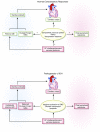Mechanisms, Clinical Implications, and Treatment of Intradialytic Hypotension
- PMID: 29483138
- PMCID: PMC6086712
- DOI: 10.2215/CJN.12141017
Mechanisms, Clinical Implications, and Treatment of Intradialytic Hypotension
Abstract
Individuals with ESKD requiring maintenance hemodialysis face a unique hemodynamic challenge, typically on a thrice-weekly basis. In an effort to achieve some degree of euvolemia, ultrafiltration goals often involve removal of the equivalent of an entire plasma volume. Maintenance of adequate end-organ perfusion in this setting is dependent on the institution of a variety of complex compensatory mechanisms. Unfortunately, secondary to a myriad of patient- and dialysis-related factors, this compensation often falls short and results in intradialytic hypotension. Physicians and patients have developed a greater appreciation for the breadth of adverse outcomes associated with intradialytic hypotension, including higher cardiovascular and all-cause mortality. In this review, we summarize the evidence for adverse outcomes associated with intradialytic hypotension, explore the underlying pathophysiology, and use this as a basis to introduce potential strategies for its prevention and treatment.
Keywords: Chronic; Fluid Therapy; Goals; Hemodialysis; Hemodynamics; Humans; Kidney Failure; Physicians; Plasma Volume; blood pressure; end-stage renal disease; hypotension; renal dialysis; ultrafiltration.
Copyright © 2018 by the American Society of Nephrology.
Figures

References
-
- Turner JM, Peixoto AJ: Blood pressure targets for hemodialysis patients. Kidney Int 92: 816–823, 2017 - PubMed
-
- Shoji T, Tsubakihara Y, Fujii M, Imai E: Hemodialysis-associated hypotension as an independent risk factor for two-year mortality in hemodialysis patients. Kidney Int 66: 1212–1220, 2004 - PubMed
-
- Dinesh K, Kunaparaju S, Cape K, Flythe JE, Feldman HI, Brunelli SM: A model of systolic blood pressure during the course of dialysis and clinical factors associated with various blood pressure behaviors. Am J Kidney Dis 58: 794–803, 2011 - PubMed
Publication types
MeSH terms
Grants and funding
LinkOut - more resources
Full Text Sources
Other Literature Sources
Medical

